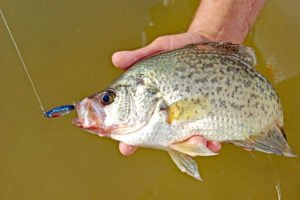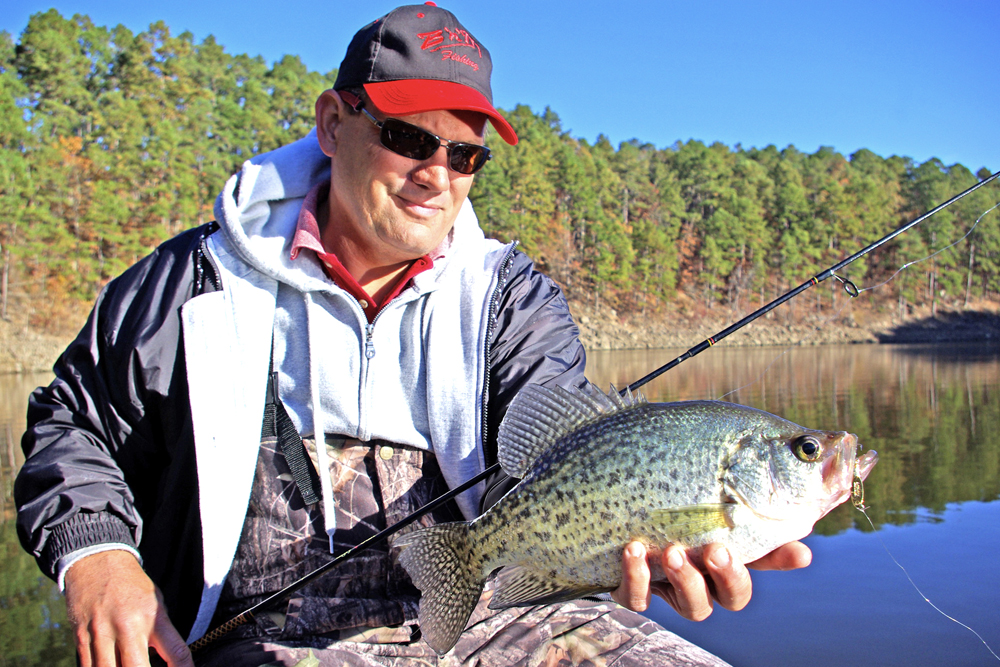Spoons can be used to catch crappie year-round, but they’re particularly effective during
winter when crappie are holding near deep cover and structure. (Photo: Keith Sutton)
Use a Spoon for Cold Crappie Medicine
by Keith Sutton
Many crappie anglers fish only with jigs or minnows, but spoons are superb crappie-catchers, too.
When I was a youngster learning to crappie fish, my uncles taught me that versatility brings success. If the jigs we brought enticed crappie, all was fine and dandy. Jigs it was.
But if jigs didn’t produce, it was time to root through the tackle box for a different come-on. Thus was I corrupted into crappie fishing with all sorts of lures. And thus, did I learn that spoons catch crappie almost as often as jigs and minnows.
Spoons are among the best lures for catching crappie on deeper structure and cover in winter. When properly pumped, cast, trolled or fluttered, these flashy metal lures wiggle like baitfish with the bends. Crappie are attracted by this action, and big catches of big panfish often result.
Size Selection
You’ll catch more crappie if you stick to 1/32- to 1/2-ounce spoons, which are easier for small-mouthed crappie to inhale. But whether a 1/32-ounce spoon or a 1/2-ounce version is best depends on various factors.
For example, when crappie are holding really deep in clear water – say 25 feet down – I opt for a heavier spoon such as the 3/8-ounce Cotton Cordell C.C. Spoon. This lure’s weight gets it into the strike zone quicker, a big plus.
For crappie on shallower features, I prefer a smaller spoon like the 1/12th-ounce Acme Kastmaster. Crappie find it irresistible, and they’re easier to hook on the smaller lure.
Choose the spoon that seems best for conditions you encounter.
Line Ties

Most spoons come pre-rigged with a split ring or snap-swivel line tie. Be sure you use it. Tying directly to the spoon inhibits the lure’s action.
For more variable action, replace the line tie with an Owner Tear-Drop Split Ring. Tying to the ring’s narrow end keeps the spoon wiggling tightly. The wide end allows a broader wobbling action. These subtle variations can make the difference between catching lots of crappie or none.
Line and Rod Selection
Most spoon-fishing strikes come as the lure falls and feel like faint taps or “heaviness” on the line. Using braided line allows easier detection of these subtle hits. Also, a fast-action rod may work better than medium- or slow-action rods typically used for crappie fishing because a too-limber rod decreases sensitivity and makes strike detection and hook-setting more difficult.
Colors
Today’s spoons are available in many hues. Which color is best? Most anglers prefer silver, white and other light colors in clear water, and go with gold, red, chartreuse or brighter colors in stained/muddy water.
Spoons also are available in realistic finishes resembling live baitfish. Crappie feeding on shad are attracted by silvery shad-like finishes. Where crappie feed largely on golden shiners, try a finish that mimics these baitfish, and so on.
Use the Right Spoon
To locate winter crappie schools, cruise over underwater creek/river channels, humps and other favored structure while pulling a trolling spoon or weedless casting spoon behind the boat.
Jigging spoons do not work well as search lures. Instead, an angler should pinpoint fish first using electronics, then position the boat directly over them before using these lures.
Conventional Jigging
Work jigging spoons with a vertical presentation. Position your boat beside target structure, then lower the lure to the bottom. Take up slack, sweep your rod tip upward 1 to 3 feet, then slowly drop the rod tip, letting the spoon free-fall but keeping “in touch” with it at all times. Repeat, and be attentive for pick-ups as the lure falls.
Casting Spoons

Casting spoons will nab crappie when cast and retrieved across horizontal structures such as submerged points or road beds. Let the lure sink, then reel up slack. Now rip the spoon off bottom by snapping the rod from a 10 o’clock position to 12 o’clock, then allow the spoon to flutter back down. Repeat this process until the lure is beside the boat. Set the hook at any unnatural bump or weightless feeling.
Alterations
When action is slow, altering a spoon may bring success. For example, in muddy water, use super-glue to attach a Bobby Garland Crappie Rattle to the spoon. The added sound helps crappie find your lure. Replace a plain treble hook with a feather-dressed treble, or add a plastic tube body, minnow or scent bait to the hook to coax more hits.
Spoon and Jig
If you feel hits but can’t hook fish, fix the problem by tying a 6-inch leader of light mono to the spoon hook then adding a crappie jig to the tag end. The smaller offering darting behind the larger spoon nabs short strikers.
Crankbait/Spoon Combo
Try working a small shad-imitation crankbait in combination with a spoon to catch inactive, suspended crappie. Tie on a three-way swivel, then add a Bandit Series 300 or similar crankbait on a 12-inch leader to one eye of the swivel, and a 1/32-ounce Kastmaster Tiger Glow Spoon or similar spoon on an 18-inch leader to the other eye. When the crankbait dives, the spoon follows, a pairing even finicky crappie find hard to resist.
Long Poling
Many spoon fishermen use a fast-action spinning or spincasting rod, but a long jigging pole or fly rod works great around shallower cover. Lower the spoon and use flicks of the wrist to load the long pole, making the lure hop erratically.
Seeing is Believing
Savvy spoon fishermen use sensitive fish-finders like Garmin’s LiveScope System that allow seeing a spoon as it is fished around crappie beneath the boat. With good sonar, you can place the lure right on a persnickety crappie’s nose and work it with various actions. Knowing you’re in the strike zone reduces frustration, encouraging you to try various tricks until one produces the desired result—a crappie in the boat.
Keith Sutton is author of “The Crappie Book: Basics and Beyond,” a 198-page, full-color paperback loaded with hundreds of fishing tips. Autographed copies can be ordered by sending a check or money order for $17.45 (includes shipping) to C & C Outdoor Productions, 15601 Mountain Dr., Alexander, AR 72002.


